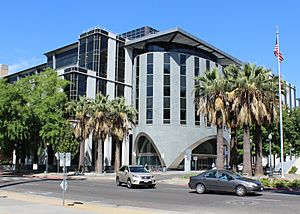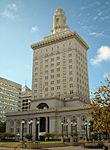Government of California facts for kids

|
|
| Polity type | Presidential republic Federated state |
|---|---|
| Constitution | Constitution of California |
| Legislative branch | |
| Name | Legislature |
| Type | Bicameral |
| Meeting place | California State Capitol |
| Upper house | |
| Name | Senate |
| Presiding officer | Eleni Kounalakis, President |
| Lower house | |
| Name | Assembly |
| Presiding officer | Robert A. Rivas, Speaker |
| Executive branch | |
| Head of State and Government | |
| Title | Governor |
| Currently | Gavin Newsom |
| Appointer | Election |
| Cabinet | |
| Name | Cabinet of California |
| Leader | Governor |
| Deputy leader | Lieutenant Governor |
| Headquarters | California State Capitol |
| Judicial branch | |
| Name | Judiciary of California |
| Courts | Courts of California |
| Supreme Court of California | |
| Chief judge | Patricia Guerrero |
| Seat | Earl Warren Building, San Francisco |
The government of California is how the state of California is run. It follows rules set by the California Constitution. California's government uses a system called separation of powers. This means it divides its work into three main parts, or "branches." These branches are the executive, the legislative, and the judicial. This system helps make sure no single part of the government has too much power.
The executive branch includes the governor of California and other elected officials. The legislative branch is the California State Legislature, which has two parts: the Assembly and the Senate. The judicial branch includes the Supreme Court of California and other courts. California also has local governments for counties, cities, and school districts. People in California can also vote directly on laws and decisions through initiatives, referendums, and recalls.
Contents
Executive Branch: Leading the State
The executive branch is responsible for carrying out the laws. It is led by the Governor of California. Other important officials are also part of this branch. These officials are elected by the people of California.
-
Gavin Newsom (D)
Governor -
Rob Bonta (D)
Attorney General -
Malia Cohen (D)
State Controller -
Tony Thurmond (D)
State Superintendent of Public Instruction

All these officials are elected for four-year terms. They can serve a maximum of two terms in the same office.
The Governor has many important jobs:
- Signing or rejecting laws passed by the Legislature.
- Appointing judges, which the voters must then approve.
- Suggesting the state's budget.
- Giving an annual speech about the state's condition.
- Leading the state's military forces.
- Granting pardons for crimes.
The Lieutenant Governor is also very important. They lead the California Senate. They also act as governor if the governor is out of the state or cannot do their job. Both the Governor and Lieutenant Governor help oversee the University of California and California State University systems.
State Agencies: Getting Work Done
California's government has many departments. Most of these departments are grouped into larger agencies. These are sometimes called "superagencies." This system helps organize the many parts of the government. For example, when Governor Pat Brown was in office, he found that about 360 different groups reported directly to him! He created the superagency plan in 1961 to make things more organized.
These superagencies act like "umbrella organizations." They help manage many smaller departments. The Governor still chooses the leaders of these smaller departments. The superagencies help the Governor focus on big issues, while the agencies handle daily tasks.
Today, the main Cabinet-level agencies (superagencies) are:
- California Business, Consumer Services and Housing Agency (BCSH)
- California Government Operations Agency (CalGovOps)
- California Environmental Protection Agency (CalEPA)
- California Health and Human Services Agency (CalHHS)
- California Labor and Workforce Development Agency (LWDA)
- California Natural Resources Agency (CNRA)
- California State Transportation Agency (CalSTA)
Some other important departments are not part of these superagencies. They are led by independently elected officials or have their own special roles:
- Department of Corrections and Rehabilitation (CDCR)
- Department of Education (CDE)
- Department of Finance (DOF)
- Department of Food and Agriculture (CDFA)
- Department of Insurance (CDI)
- Department of Justice (DOJ)
- Military Department
Independent Groups: Special Roles
Many other groups work independently from the main agencies. Their leaders are usually chosen by the Governor and approved by the state Senate. Even though they are independent, the Governor can still influence them over time. This happens by appointing new leaders who agree with the Governor's goals.
Examples of these independent groups include:
- Regents of the University of California
- California State University Board of Trustees
- California Community Colleges Board of Governors
- California Public Utilities Commission
- California State Auditor
- Fair Political Practices Commission
Legislative Branch: Making Laws

The California State Legislature is the part of government that makes laws. It has two parts, making it a bicameral body:
- The California State Assembly: This is the lower house, with 80 members.
- The California State Senate: This is the upper house, with 40 members.
Members of the Assembly serve two-year terms. Members of the Senate serve four-year terms. About half of the Senate seats are up for election every two years.
The speaker of the California State Assembly leads the State Assembly. The Lieutenant Governor leads the Senate and can vote if there is a tie. The president pro tempore of the California State Senate is chosen by the main political party in the Senate.
The Legislature meets in the California State Capitol in Sacramento. The laws they pass are published and organized into 29 different California Codes.
Judicial Branch: Interpreting Laws
The judicial branch of California's government explains and applies the laws. It is set up by the California Constitution and other laws. The court system has different levels, with the Supreme Court at the very top.
The superior courts are the main trial courts. This is where most cases start. The courts of appeal handle appeals from these trial courts.
The Judicial Council helps make rules for the court system.
Supreme Court of California
The Supreme Court of California has one chief justice and six associate justices. This court handles certain types of cases first, like those about habeas corpus (a legal way to challenge being held in prison). It also decides which cases from the courts of appeal it wants to review. The Supreme Court must review all cases where the death penalty has been given.
Courts of Appeal
The courts of appeal are the next level down. They review decisions made by the superior courts. California is divided into six areas for these courts. All published decisions from these courts must be followed by all superior courts in the state.
Superior Courts
The superior courts are the general courts. They hear and decide almost any civil or criminal case. Each of California's 58 counties has a superior court, as required by the Constitution. These courts also have special divisions that hear appeals from smaller cases. These smaller cases include minor offenses like infractions, misdemeanors, and civil cases involving less than $25,000.
Direct Democracy: People's Power
The California Constitution allows people to participate directly in their government. This is called direct democracy. It happens in a few ways:
- Initiative: Citizens can propose new laws or constitutional changes and vote on them.
- Referendum: Citizens can vote to approve or reject laws passed by the Legislature.
- Recall: Citizens can vote to remove an elected official from office before their term ends.
Local Government: Running Communities
California is divided into 58 counties. These counties are legal parts of the state. There are also 482 cities in California. On top of that, there are about 1,102 school districts and 3,400 special districts.
Counties and cities can create their own local laws, called ordinances. These laws are usually organized into county or city codes. Breaking these laws is often a misdemeanor crime. School districts are separate from cities and counties. They are in charge of public education. Special districts provide specific services, like water or fire protection, to certain areas.
- City halls in California
See also
 In Spanish: Gobierno de California para niños
In Spanish: Gobierno de California para niños




















